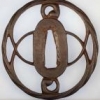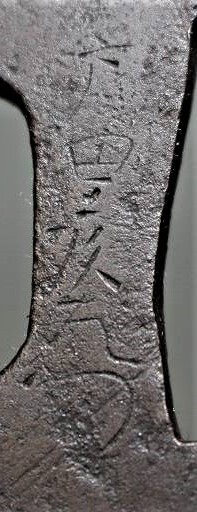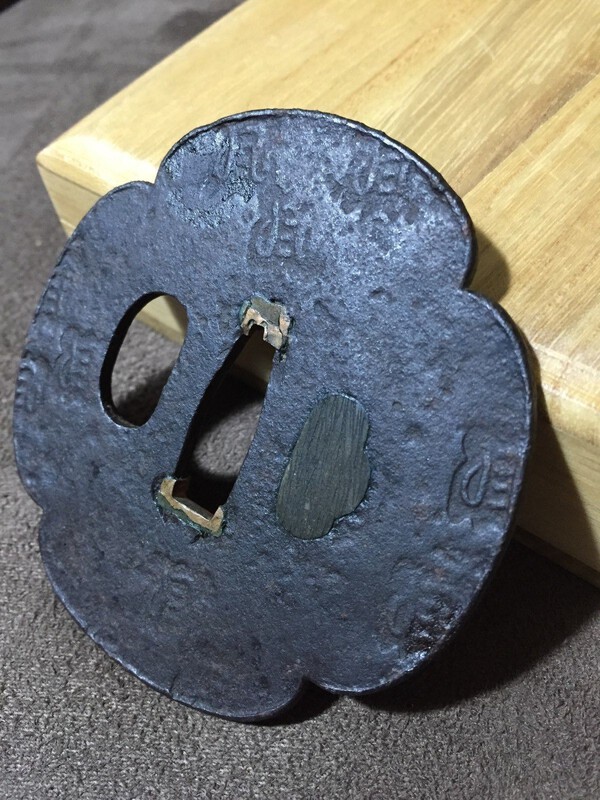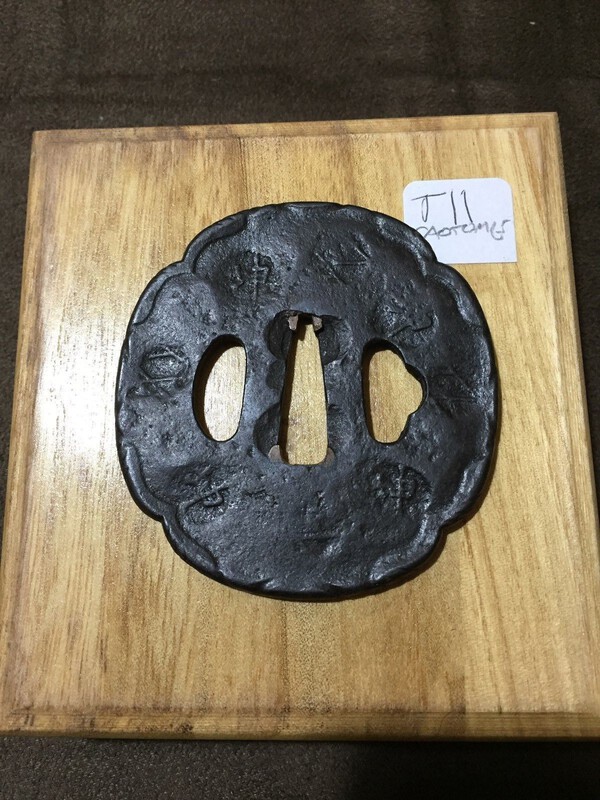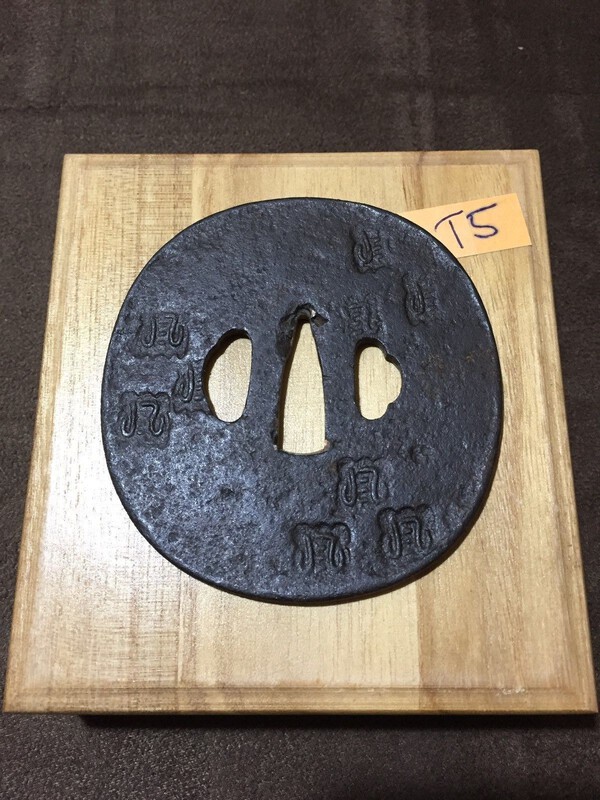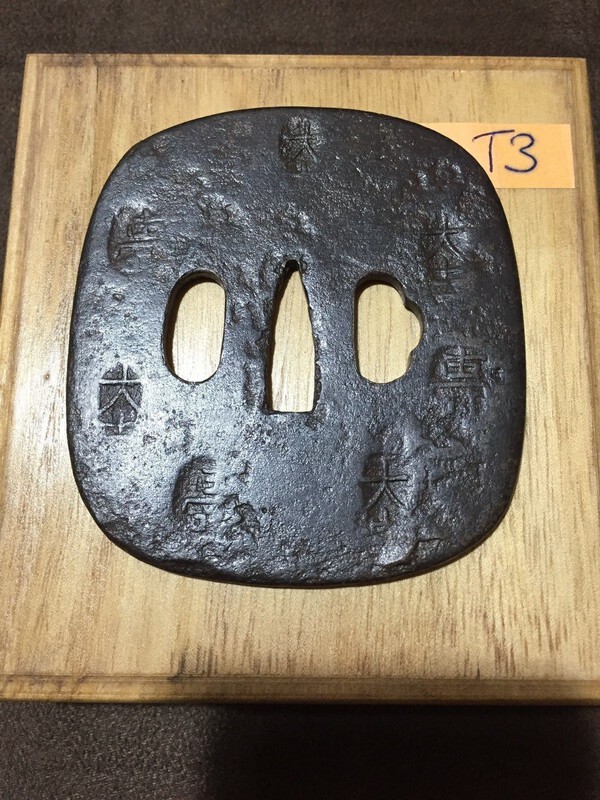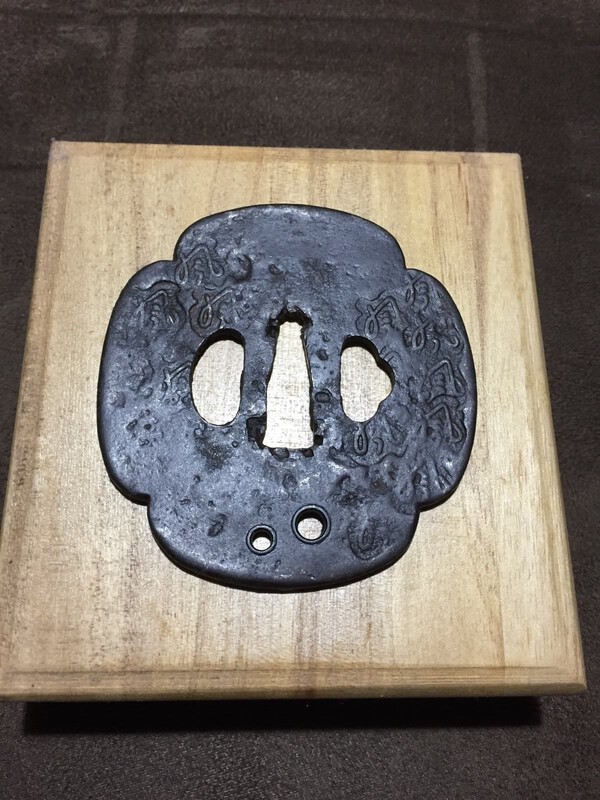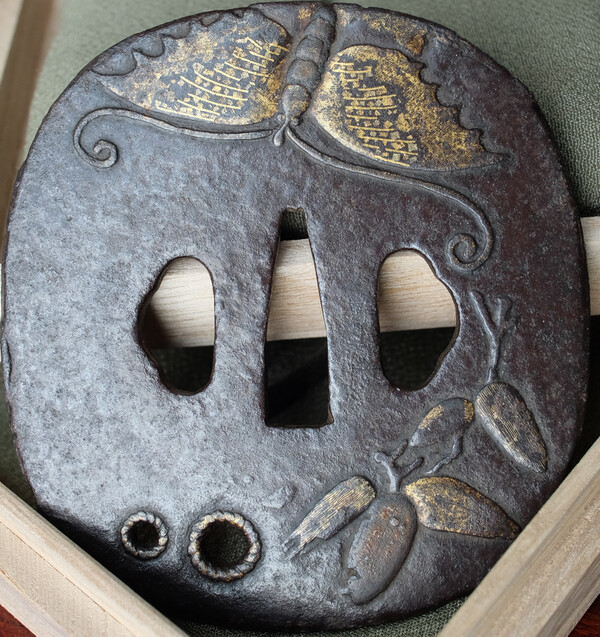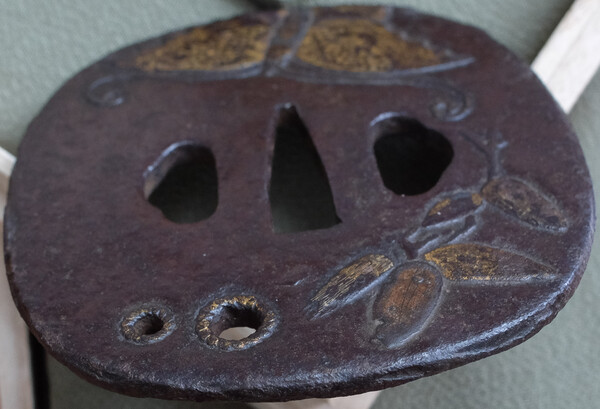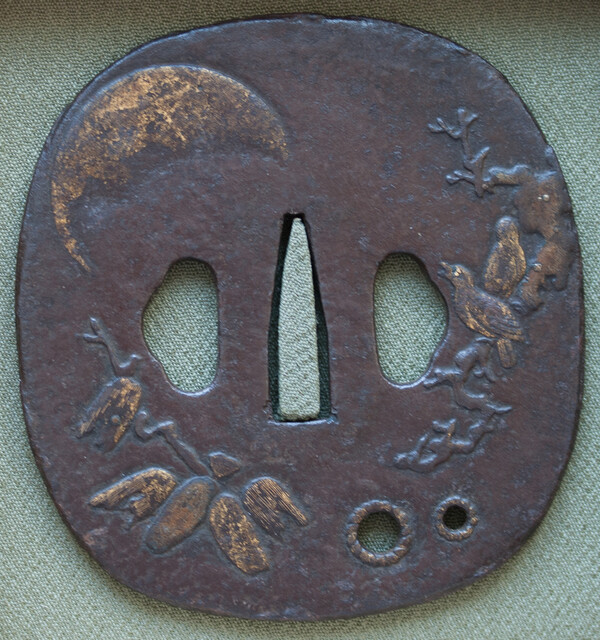-
Posts
323 -
Joined
-
Last visited
Content Type
Profiles
Forums
Events
Store
Downloads
Gallery
Everything posted by lotus
-
Richard - I agree on both points. I felt the second one ticked the most boxes for the style (mokko, folded rim, diagonal grroves, fairly thick, nice deep patina). However, it is a bit smaller in size. Oh, and I found that exact Tsuba on a web site talking about Tenpo so I felt it the "safe" choice. The others, as you said and I agree with are probably mediocre later era pieces. Even the 2nd one might not be that early considering it's size... Oh, and I love your Tenpo Tsuba you attached! Pat
-
See attached, seller was not able to see it clearly enough to tell me. I adjusted the clarity a bit, hope it helps. Can anyone make it out?
-
I have not posted in ages but started back up studying tsuba again. I was looking at these 5 Tenpo (Edo era) and am just starting to read up a bit on this type of tsuba. I was hoping you guys could help me evaluate this lot of 5 Tenpo tsuba. Was interested in knowing if they all appear to be authentic and how would you rank them from best to worst (quality / workmanship)? I am attaching a single image of each and here are the dimensions : Tenpo 1 - 8.00 x 7.65 x 0.30 cm Yamashiro Tenpo, iron plate with thin sukidashi mimi, kozuka ana and kogai ana with sakudo copper plug (umegane) Tenpo 2 - 7.35 x 7.05 x 0.40 cm Saotome Tenpo, has typical folded rim at the four “corners” with grooves diagonally around mimi, two hitsu (one kozuka and one kogai). Has top and bottom sekigane. Tenpo 3 - 8.60 x 8.15 x 0.35 cm Yamashiro Tenpo tsuba for katana, nakegaku (rounded square), fine tsukidashi rim, thinner iron plate. Tenpo 4 - 8.60 x 7.80 x 0.35 cm Yamashiro Tenpo tsuba for katana, nakegaku (rounded square), rounded rim maru mimi, iron plate (itagane) Tenpo 5 - 8.20 x 7.60 x 0.35 cm Yamashiro Tenpo, good itagane (forged iron plate) of rounded mokkogata (4 lobe shape), sukidashi mimi, 2 hitsu ana Thanks! Patrick R.
-
-
I was just surprised at its weight. Though, in thinking about it a bit more, I have only handled sukashi tsuba. With much of the metal cut out, of course they would be lighter. It was more an observation in relation to the other "lighter" tsubas I own...
-
Thank you Lance for your opinion and I have been doing some more research and it certainly could fit that style. I am attaching some better photos which I am hoping might help the cause...
-
Wanted to get your thoughts on this one. It is heavy considering how darn thin it is. It also has this deep warm brown finish on it. Some type of lacquer perhaps? It is somewhat smooth. I would guess Shoami? Dimensions are 8.4mm tall x 7.9mm tall x 4mm thick
-
-
Yeah, the only similarity with Saotome seemed to be the rim shape. I also noticed the zogan inlay of the water wraps around the rim and continues on the back side. So, if you were to envision folding out the front and back sides of the tsuba, you would have a complete picture. Not sure if that helps narrow anything down or not, but just thought it was interesting.
-
The only reason I mentioned Higo is because the seller had it in his description which I no longer have due to a computer crash. Umetada is a very interesting attribution. I am going to have to do more research into that school. I love the feel of the iron and the abundance of hammer work. I have been looking for similar umetada examples on the web without much luck. If you know of any, let me know. In looking on the web, I did also notice the Saotome school did a lot of flower petal rims.
-
Looks cast to me. You can see the some flashing that has not been filed away.
-
The attached tsuba certainly appears to be done in the Higo style. Any thoughts on it? Age and authentic? Thanks!
-
I would add the soft gold color of the brass inlay is another point that this is an older piece. Very nice, despite what looks to be some later poorly done carving. Interesting piece.
-
Christian - Thanks for the great info. And yes, the iron finish was what I was referring too. But now that I have looked at my Sasano books, I do see a similarity in the iron to the early pieces. Also, I see what you mean about the similarity of the style of those periods. They tended to be simpler in design, more airy, and sometimes harder to intepret. I had no idea it could be that old. I wonder how it would paper? Do they distinguish between the old versus newer Tochibata schools? Or would it paper just Tochibata I wonder? Definately a keeper. Do you know where I can purchase that Sukashi Tsuba book from? Thanks!
-
From a previous NMB thread, someone posted a tochibata from a book with a very similar rim as mine. The rest of the design is more chunky than mine though.
-
Finally able to post some pics of my tsuba. The tsuba is small and light and the iron has a peculiar graininess to it which leads me to my first question. Based on the attached pics, would you say this tsuba is authentic?
-
Nice tekkotsu!!! LOL...
-
Agreed, the pics look very grainy/noisy too me. Seller only had an omote/ura pic with the same issue. Unfortunately, that grain/noise makes it impossible to gauge the nature of the iron. Description stated it has a dark, rich brown patina. The design has a very modern feel to it, does it not? Seller described it as delicate and understated. Though I would not descibe the previous Tochibata tsubas I have seen that way... I will take more and better pics of it when it arrives.
-
Well, based on the Sasano example and the bold tekkotsu, I think it could just as easily be a ko-shoami piece. Some of the early ko-shoami pieces have very Owari-like iron.
-
Bit of an odd Tsuba as I cannot really locate one that is too similar. Perhaps a late model Tochibata? I only say this because rope rims were their mainstay? If not, what do you all think? First pic is tsuba in question. Second pic is a tsuba I found attributed to Tochibata. As close as I could find... Dimenstions : Thickness 4.7mm Width 63.5mm Height 67.3mm
-
Perhaps it is an Owari-Kyo? An Owari guard influenced by Kyo design. In any case, it is an absolutely wonderful tsuba!
-
Quoted from Jim Gilbert's site : The tekkotsu on the rim and the rougher finish of the iron lend me to think Owari. However, as you say, the thin walls and design are much, much more Kyo influenced. Due to the thinness, one would think the metal would have to be softer as well. Slightly rounded rim, asymmetry, and narrow seppa-dai are seen more in Kyo works. My vote would be that it is a Kyo guard with some Owari spices thrown into it (Kyo-Owari).
-
That explains why it did not quite fit either one. I will look into this Tochibata. Thanks guys and enjoy Tampa, I am jealous!!
-
I am trying to identify the attached tsuba. Dimensions are round 80x80x6mm (thick). The Japanese to English translation of the description contains both Kanayama and Owari words. From references, the large size and rounded rim (rounded everything really) and non-elongated hitsu-anas do not seem to fit Kanayama. It seems to fit an Owari attribution slightly better due to overall size not too mention Owari likes the bracken design. Does not seem delicate enough for Kyo and too symmetrical with no sense of movement to be Ko-Shoami. What do you guys in the know think?
-
Yeah, that was the one I saw in the book. I must have been tired when I read the caption as I thought it read first hereditary master not fifth. My mistake. I think it probably is later like you mentioned as those nice ko-akasaka are rather expensive. Still, it is a vast improvement over that cast tsuba I returned.


